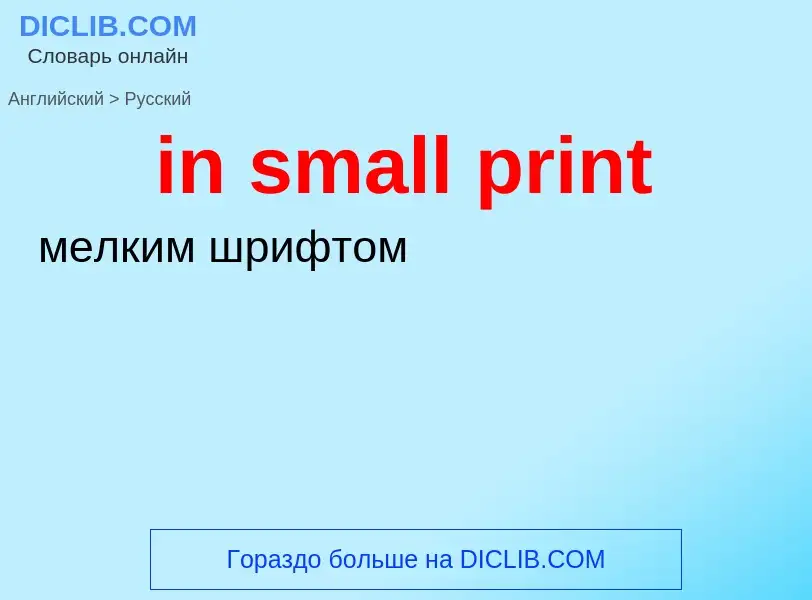Перевод и анализ слов искусственным интеллектом ChatGPT
На этой странице Вы можете получить подробный анализ слова или словосочетания, произведенный с помощью лучшей на сегодняшний день технологии искусственного интеллекта:
- как употребляется слово
- частота употребления
- используется оно чаще в устной или письменной речи
- варианты перевода слова
- примеры употребления (несколько фраз с переводом)
- этимология
in small print - перевод на русский
[smɔ:l'print]
общая лексика
мелкая печать
мелкий шрифт
(the small print)
важная информация
напечатанная мелким шрифтом на неприметном месте (в контракте, полисе и т. п.)
оговорка
сделанная как бы вскользь
но меняющая суть дела
существительное
общая лексика
мелкая печать, мелкий шрифт
важная информация, напечатанная мелким шрифтом на неприметном месте (в контракте, полисе и т. п.)
Определение
Википедия

Fine print, small print, or mouseprint is less noticeable print smaller than the more obvious larger print it accompanies that advertises or otherwise describes or partially describes a commercial product or service. The larger print that is used in conjunction with fine print by the merchant often has the effect of deceiving the consumer into believing the offer is more advantageous than it really is. This may satisfy a legal technicality which requires full disclosure of all (even unfavorable) terms or conditions, but does not specify the manner (size, typeface, coloring, etc.) of disclosure. There is strong evidence that suggests the fine print is not read by the majority of consumers.
Fine print may say the opposite of what the larger print says. For example, if the larger print says "pre-approved" the fine print might say "subject to approval". Especially in pharmaceutical advertisements, fine print may accompany a warning message, but this message is often neutralized by the more eye-catching positive images and pleasant background music (eye candy). Sometimes television advertisements flash text fine print in camouflagic colors, and for brief periods of time, making it difficult or impossible for the viewer to read.
The use of fine print is a common advertising technique in certain market niches, particularly those of high-margin specialty products or services uncompetitive with those in the mainstream market. The practice, for example, can be used to mislead the consumer about an item's price or value, or the nutritional content of a food product.
In the US, the Federal Trade Commission (FTC) regulations state that, for an advertised offer to be lawful, the terms of the offer must be clear and conspicuous, not relegated to fine print. US FTC regulations state that unfair or deceptive acts or practices in or affecting commerce are unlawful. (15 USC § 45 (a)) In relevant part, they state that contingent conditions and obligations of an offer must be set forth clearly and conspicuously at the outset of the offer, and that disclosure of the terms of the offer set forth in a footnote of an advertisement to which reference is made by an asterisk or other symbol placed next to the offer, is not regarded as making disclosure at the outset. (16 CFR 251.1)


![[[Political endorsement]] signs often have fine print disclaimers. [[Political endorsement]] signs often have fine print disclaimers.](https://commons.wikimedia.org/wiki/Special:FilePath/Minnesota Tax Cut Rally 2011 (5697256303).jpg?width=200)
